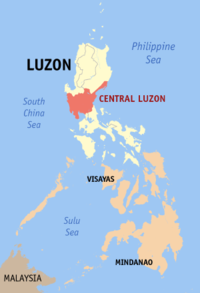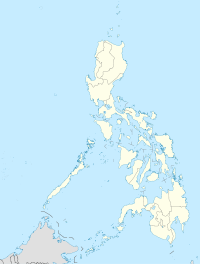- Muñoz, Nueva Ecija
-
Science City of Muñoz — City —
SealMap of Nueva Ecija showing the location of Science City of Muñoz. Location in the Philippines Coordinates: 15°42′58″N 120°54′11″E / 15.71611°N 120.90306°ECoordinates: 15°42′58″N 120°54′11″E / 15.71611°N 120.90306°E Country  Philippines
PhilippinesRegion Central Luzon (Region III) Province Nueva Ecija District 2nd District Founded Cityhood June 9, 2000 Barangays 37 Government – Mayor Efren L. Alvarez Area – Total 163.05 km2 (63 sq mi) Population (Dec 2009) – Total 85,451 – Density 524.1/km2 (1,357.4/sq mi) Time zone PHT (UTC+8) ZIP Code 3119 Income class 5th class city; component Website sciencecityofmunoz.ph Science City of Muñoz is a city in Central Luzon, Philippines, situated 147 kilometres (91 mi) north of the capital Manila. Due to its rich topography and tropical climate, it is now home to agricultural research and technology centers, committed to the production of information and technological breakthroughs to promote rural development, productivity and food security.
From its lowly origins as “Sitio Papaya”, it was rechristened as Muñoz in 1886 in honor of Spanish Governor Don Francisco Muñoz. It was in 1913, under Executive Order No. 72, wherein Muñoz was declared as a new and independent municipality.
With a bustling market center wherein rice trading was a major economic activity, it has metamorphosed into its present stature, unprecedented in the annals of the country as a Science City by virtue of Republic Act 8977 on December 9, 2000.
The overriding objective of transforming Muñoz into a center of science and technology, trade, commerce and agro-industry is now achievable as the city is now financially sound to implement and translate into reality its conceptualized framework of total development.
Being a science city, Muñoz was acknowledged as one of the members of League of Cities of the Philippines and became a pilot city of achieving the United Nation’s Millennium Development Goals.
Contents
Vision
“The Science City of Muñoz as an exemplar of good local governance, progressive and globally competitive, promoting the application of agricultural science, technologies, culture and the arts in an atmosphere of harmony and peace."
Mission
The Science City of Muñoz capitalizes on the presence of the various Research and development Centers and other related institutions to advance its mission, that is: to unite this institutions and establish a common direction in transforming the countryside into a huge learning laboratory for technology promotion, rural development, productivity and profitability, and educational and agro-tourism, and center for culture and the arts.
History
From Sitio to Barrio
In 1886, Papaya was changed into 'Muñoz' to honor Don Francisco Muñoz, the province’s alcalde mayor, and the community’s first appointed gobernadorcillo. Muñoz was annexed as a barrio of San Juan de Guimba municipality. Settlers trickled in from Bulacan and the Ilocos Region. In 1911, Factoria (now San Isidro town), the provincial capital, was totally flooded. Muñoz was then considered a possible new capital of the province.
At about the same time, the people of Barrios Muñoz and San Antonio, also in San Juan de Guimba town, and Palusapis in Sto. Domingo municipality, together with Sitios Kabisukulan, Rang-ayan, Mataas na Lupa, Siniguelas, Purok Agrikultura, and Pulong Maragul in Talavera town, were organizing themselves to be separated from their three respective municipalities to become a new independent municipality. They were prepared to construct a municipal hall and a school building for the emerging town.
From Barrio to Town
Upon recommendation of the Provincial Board of Nueva Ecija, then headed by Governor Isauro Gabaldon, and with approval of then Acting Governor General Newton Gilbert, the organized barrios and sitios were granted independence as a regular municipality on January 10, 1913 under the name of Muñoz. The seat of the fledgling municipal government was positioned in erstwhile Barrio Muñoz. Thus, the municipality of Muñoz was born, and steadily grew to become today an Agricultural Science City in-the-making
Muñoz owes a tremendous lot to its early leaders — Tranquilino Delos Santos, and other homesteaders Luis Ramos, Ambrosio Medina, Cayetano Caisip, Victorino Pornuevo, and Precy Hill Delos Santos. A municipal hall, a church building, and a small public market were erected in Lumang Bayan (now Poblacion North). A road linking the young Muñoz town with the national highway from Barangay Bacal, Talavera was also constructed.
Muñoz continued to attract more settlers. More barrios were established and were named after their peoples’ ideals and aspirations, landmarks, and personalities such as Rang-ayan (prosperity), Linglingay (recreation), Mangandingay (company), Magtanggol (defense), and Villa Isla (in a leader’s honor).
Muñoz was not spared from the pains of the Second World War. Being the last stronghold of the Japanese Imperial Army while scampering to the Cordilleras, the Allied liberation in Muñoz by the country by joint United States and Philippine Commonwealth forces offensive razed the town to the ground in a matter of days.
Center of Excellence and Major Knowledge Node in Food Security Research and Development
- Philippine Rice Research Institute (PhilRice)
- Central Luzon State University (CLSU)
- Philippine Carabao Center (PCC)
- PHILMECH - Philippine Center for Postharvest Development and Mechanization formerly known as
- Bureau of Postharvest Research and Extension (BPRE)
- Bureau of Fisheries and Aquatic Resources (BFAR)
- National Freshwater and Fisheries Training and Research Center (NFFTRC)
- National Irrigation Administration - Casecnan Multi-purpose Irrigation and Power Project (NIA-CMIPP)
- National Irrigation Administration – Upper Pampanga River Integrated Irrigation System (NIA-UPRIIS)
- Department of Environmental & Natural Resources (DENR)
- Department of Science & Technology – Provincial Science & Technology Center – (DOST –NE )
- Regional Science & Training Center (RSTC)
- Philippine-Sino Center for Agriculture Technology (PhilsCAT)
- National Small Ruminant Center (NSRC)
- Soil and Water Resources Management Center(SWRMC)
- Regional Crop Protection Center (RCPC)
- Ramon Magsaysay Center for Agricultural Resources and Environmental Studies (RMCARES)
- Fruits and Vegetables Seeds Center (FVSC)
- Philippine-Israel Center for Agricultural Technology (PICAT)
Barangays
Muñoz is politically subdivided into 37 barangays:
- Bagong Sikat
- Balante
- Bantug
- Bical
- Cabisuculan
- Calabalabaan
- Calisitan
- Catalanacan
- Curva
- Franza
- Gabaldon
- Labney
- Licaong
- Linglingay
- Mangandingay
- Magtanggol
- Maligaya
- Mapangpang
- Maragol
- Matingkis
- Naglabrahan
- Palusapis
- Pandalla
- Poblacion East
- Poblacion North
- Poblacion South
- Poblacion West
- Rang-ayan
- Rizal
- San Andres
- San Antonio
- San Felipe
- Sapang Cawayan
- Villa Isla
- Villa Nati
- Villa Santos
- Villa Cuizon
Schools
- Elementary and Pre-elementary Schools:
-
- 37 Public Elementary Schools and 37 Daycare Centers
- Accelerated Christian International Schools
- Guiding Star Learning Center
- Adonai Integrated Montessori School
- United Methodist Learning Center
- ACLEAD
- JDS Montessori
- Kelston Montessori
- Hellen Keller Montessori
- Little Lamb Montessori
- Secondary:
-
- Muñoz National High School
- Muñoz National High School Annex
- CLSU Science High School
- Agricultural Science and Technology High School
- Palusapis Outreach School
- San Sebastian School
- Science City Montessori
- Adonai Integrated Montessori School
- Tertiary:
-
- Central Luzon State University
- CLSU Computer Training Center
The Millennium Development Goals or MDG
- Goal 1: Eradicate Extreme Poverty and Hunger
- Goal 2: Achieve Universal Primary Education
- Goal 3: Promote Gender Equality and Empowerment Women
- Goal 4: Reduce Child Mortality
- Goal 5: Improved Women’s Reproductive Health
- Goal 6: Combat HIV/AIDS, Malaria and Other Diseases
- Goal 7: Ensure Environmental Sustainability
- Goal 8: Develop a Global Partnership for Development
References
External links
- Pasyalan Nueva Ecija
- Science City Of Muñoz Official Website
- Philippine Standard Geographic Code
- 2000 Philippine Census Information
- Inquirer.net, Carabao may be key to biofuel, says scientist
Municipalities Component cities - Cabanatuan
- Gapan
- Muñoz
- Palayan
- San Jose
 Cities of the Philippines
Cities of the PhilippinesHighly-urbanized Cities Angeles · Bacolod · Baguio · Butuan · Cagayan de Oro · Caloocan · Cebu · Davao · General Santos · Iligan · Iloilo · Lapu-Lapu · Las Piñas · Lucena · Makati · Malabon · Mandaluyong · Mandaue · Manila · Marikina · Muntinlupa · Navotas · Olongapo · Parañaque · Pasay · Pasig · Puerto Princesa · Quezon City · San Juan · Tacloban · Taguig · Zamboanga
Independent
Component CitiesComponent Cities Alaminos · Antipolo · Bago · Bais · Balanga · Batangas · Batac · Bayawan · Baybay · Bayugan · Biñan · Bislig · Bogo · Borongan · Cabadbaran · Cabanatuan · Cadiz · Calamba · Calapan · Calbayog · Candon · Canlaon · Carcar · Catbalogan · Cauayan · Cavite · Danao · Dapitan · Dasmariñas · Digos · Dipolog · Dumaguete · El Salvador · Escalante · Gapan · Gingoog · Guihulngan · Himamaylan · Iriga · Isabela · Kabankalan · Kidapawan · Koronadal · La Carlota · Lamitan · Laoag · Legazpi · Ligao · Lipa · Maasin · Malaybalay · Malolos · Marawi · Masbate · Mati · Meycauayan · Muñoz · Naga, Cebu · Oroquieta · Ozamiz · Pagadian · Palayan · Panabo · Passi · Roxas · Sagay · Samal · San Carlos, Negros Occidental · San Carlos, Pangasinan · San Fernando, La Union · San Fernando, Pampanga · San Jose · San Jose del Monte · San Pablo · Santa Rosa · Silay · Sipalay · Sorsogon · Surigao · Tabaco · Tabuk · Tacurong · Tagaytay · Tagbilaran · Tagum · Talisay, Cebu · Talisay, Negros Occidental · Tanauan · Tandag · Tangub · Tanjay · Tarlac · Tayabas · Toledo · Trece Martires · Tuguegarao · Urdaneta · Valencia · Victorias · Vigan
Regional Center 
Highly Urbanized Cities Metropolitan Areas Provinces Component Cities Balanga City • Cabanatuan City • Gapan City • City of Malolos • Meycauayan City • Munoz City • Palayan City • San Fernando, Pampanga • San Jose City • San Jose del Monte City • Tarlac CityLuzon, Republic of the PhilippinesCategories:- Cities in the Philippines
Wikimedia Foundation. 2010.




